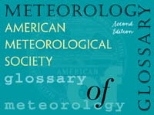What's the difference between a "piner" and a "pisachee"? What's a "pingo"? Or a "pirry"? The answers may be found on page 425 of the Glossary of Meteorology,originally published by the American Meteorological Society (AMS) in 1959. But search for terms such as "helicity," "climate change," and "nested grid model" from among the 7,000-plus available, and you'll come up empty.
In fact, entire branches of meteorology have been born and evolved since the glossary's first publication.
Now, 41 year later, the AMS has published the Glossary of Meteorology, Second Edition. The new edition contains approximately 12,300 terms in an 850-page volume (available on CD-ROM as well), and includes not only meteorological terms but others from the related oceanic and hydrologic sciences.
The six-year project was conducted under the leadership of managing editor Todd Glickman (SB 1977), who was assistant executive director of the AMS before joining the MIT Office of Corporate Relations in early 2000.
Mr. Glickman's mostly volunteer staff included many from the MIT community, including senior technical editors Richard Hendl (PhD 1974) and Ronald Podsiadlo (SM 1965), advisory board members John D. Stackpole (SM 1959), Ferris Webster (PhD 1961) and the late Ralph E. Huschke (SB 1946).
Professor Kerry Emanuel (PhD 1978) of earth, atmospheric, and planetary sciences (EAPS) served as subject area editor for hurricanes and tropical meteorology.
Other contributors included graduate students Auroop Ganguly, Nicole Gasparini and Jeffrey Niemann; research affiliate Gregory Tucker, research scientist Jingfeng Wang (ScD 1997) and principal research engineer Earle Williams (SB 1981), all in the Department of Civil and Environmental Engineering (CEE); Professor Dara Entekhabi (PhD 1990) of EAPS and CEE; and alumni Dale Durran (PhD 1981), James Franklin (SM 1984), Marvin Geller (PhD 1969), C.T. Gordon (PhD 1971), Edwin Kessler (ScD 1957), Stephen Lancaster (PhD 1998), Professor Emeritus Frederick Sanders (ScD 1954), William Sommers (PhD 1967), Kevin Speer (PhD 1988) and Dayton Vincent (PhD 1970).
The definitions:
Pisachee (same as peesash): A hot, dry, dust-laden wind of India.
Pingo: A large frost mound of more than one year's duration.
Pirry (same as perry): A sudden, heavy fall of rain; a squall in England, sometimes referred to as "half a gale."
Helicity: One-half the scalar product of the velocity and vorticity vectors.
Climate change: Any systematic change in the long-term statistics of climate elements (such as temperature, pressure or winds) sustained over several decades or longer.
Nested grid: A high-resolution region of discretization embedded within a low-resolution region of a numerical model or analysis system.
Ordering information may be found on the AMS web site.
A version of this article appeared in MIT Tech Talk on December 6, 2000.






